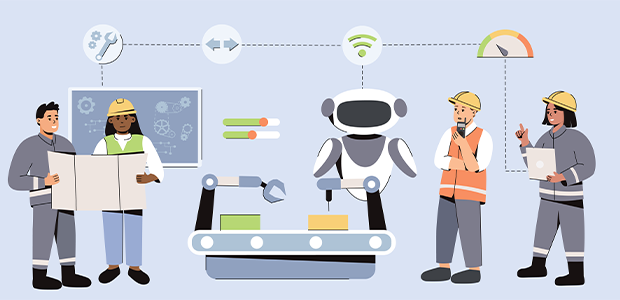
How Computer Vision is revolutionising manufacturing
In today's digital-centric environment, manufacturers are looking to enhance efficiency and increase productivity to stay competitive. It’s a goal that must be achieved against a backdrop of challenges such as labour shortages, supply chain bottlenecks, cost pressures, and even mounting cyberattacks.
Some issues are unique to subset areas of manufacturing. For example, surface mount technology (SMT) manufacturers are dealing with issues such as the miniaturisation of components, component availability, increasing circuit board complexity, High-Mix Low-Volume (HMLV) production, quality control, process traceability, technological advancements, environmental regulation, and how to address the shortage of skilled workers.
To achieve its goals, the manufacturing industry is embracing digital transformation by investing in smart manufacturing technologies, including automation, data analytics, and advanced connectivity solutions. These technologies enhance efficiency, reduce costs, and streamline operations while improving product quality. But one of the technologies often under-recognised by the wider world in this transformation is the application of AI-powered Computer Vision technology.
The Adoption of AI
Manufacturers are rapidly adopting advancements in sensing, artificial intelligence (AI) and machine learning (ML) to boost profitability and cut production times. AI and ML enable smarter production processes with predictive maintenance, improved quality control, and automated decision-making,
Within AI, Computer Vision technology allows systems to derive meaningful information from digital images. As the "eyes of AI," Computer Vision observes, identifies, classifies, tracks, and interprets images into usable knowledge that can be further analysed by humans or complementary AI systems.
Unlike large language model-based solutions such as ChatGPT, which are at the "peak of inflated expectations" in Gartner’s hype cycle, Computer Vision technology is more advanced and expected to reach its productivity plateau within the next two years.
Computer Vision Technology Set to Drive Productivity
According to recent Panasonic research involving 300 digital transformation and AI/Computer Vision decision-makers, Computer Vision technology is expected to drive productivity increases of 42% on average over the next three years. Manufacturing decision-makers are particularly optimistic, predicting productivity increases of 52% over the same period – the highest among surveyed sectors. Ultimately, productivity gains can lead to increased operational efficiency and profitability, enabling manufacturers to invest in new technologies and processes.
Practical applications such as repairs, monitoring, and quality control are most likely to employ Computer Vision technology. Manufacturing companies are adopting Computer Vision for quality control testing and inspection more than other sectors. Specifically, 42% of respondents use it for repair and maintenance, while 40% use it for quality control and inspection. This could include the inspection of solder joints, component placement, and verifying the integrity of circuit boards.
Additionally, 28% of manufacturers use Computer Vision for volume measurement, including pallet volume for efficient loading and transportation, the highest rate among surveyed industries.
Accelerating Production Without Compromising Quality
Computer Vision applications in manufacturing can be diverse. They range from operational use in automated precision pattern cutting and welding to adjacent processes such as quality control, inspection, monitoring, and packaging. These applications help accelerate production without compromising quality or accuracy.
Looking to the future, rapid improvements in Computer Vision technology will likely assist manufacturers further in two additional areas:
- Electronics Final Assembly: When products leave the automated production line, additional components often need to be inserted or sub-assemblies connected to main boards. Currently, this task is often performed by people; however, Computer Vision can increase accuracy and sensitivity, helping to overcome these challenges.
- Analysing and Optimising Operator Movements: Computer Vision will enable manufacturers to automatically analyse and optimise the movements of operators inside a factory and in manufacturing cells. This can rapidly improve efficiency, and help to identify the source of any significant product quality issues that may be caused by human error.
Overcoming Technological and Ethical Barriers
While the benefits are clear, there are technological and business barriers to overcome when deploying Computer Vision. The two most common issues are a lack of third-party/outsourced support to implement (42%) and maintain the technology (40%).
Ethical concerns related to privacy and data security also pose challenges. Data security concerns were cited by 46% of manufacturers, higher than the overall average of 35%. Additionally, 36% of manufacturing respondents expressed concerns about existing AI tool regulations, compared to the industry average of 27%. With the protection of organisational and industry IP of paramount importance within manufacturing, this should be top-of-mind for decision makers.
AI Uptake Increasing
Regarding the general adoption of AI, 18% of manufacturers have already implemented AI and are starting to see short-term benefits, while nearly a quarter (24%) are in the planning process. Overall, AI is crucial in manufacturers' business transformation journey, with 74% saying it is very important and 24% saying it is somewhat important. Should AI technologies be implemented successfully, it can lead to improved process optimisation, reduced downtime, and enhanced product quality and output.
Revolutionising Manufacturing
Computer Vision is setting the stage for a revolution in manufacturing, enabling significant productivity and efficiency gains, automating many processes, enhancing quality control, and accelerating innovation. It will be interesting to see how Computer Vision technology continues to transform the manufacturing sector over the next two years and whether these ambitious expectations are met or even exceeded.

